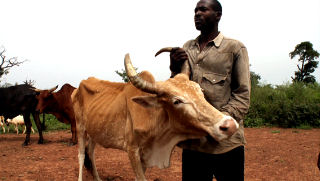Researchers at the University of Liverpool have identified two genes that may prove key to protecting against African sleeping sickness in people and a wasting disease in cattle.
Cases of sleeping sickness infections in people have fallen in the last 13 years, from an estimated 300,000 incidences a year in 1998, to 30,000 in 2009. It kills more than half of those infected, but also affects cattle in the animal form of the disease – African animal trypanosomiasis – resulting in an annual economic loss of $4 billion.
Scientists, working with partners in the UK and Africa, investigated the differences in the disease between the humped cattle breed and the humpless West African breed, called N’Dama. The N’Dama are the oldest of African cattle breeds and are not seriously affected by the condition, as it has evolved resistance to the parasite over a long period time.
The N’Dama, however, is smaller and produces less milk than the humped cattle, and scientists have, therefore, been working to understand if disease resistance in one breed could be transferred to another.
Combining a range of genetic approaches, that had previously only been used separately, scientists identified the broad regions of the genomes in both breeds of cattle that control the different responses to infection with trypanosome parasites. The team used gene expression analyses and sophisticated computer software to read the complex biological data quickly and accurately. From this information scientists identified two genes that could have evolved in response to the presence of trypanosome parasites.
Dr Harry Noyes from the Institute of Integrative Biology said: “We believe the reason the N’Dama do not fall sick when infected with trypanosome parasites is that these animals, unlike others, have evolved ways to control the infection without mounting a runaway immune response that ends up damaging them. Many human infections trigger similarly self-destructive immune responses, and our observations may point to ways of reducing such damage in people as well as livestock.”
Stephen Kemp, Professor at the University and scientist at the International Livestock Research Institute, said: “In addition to advancing our understanding of the cascade of genes that allow Africa’s N’Dama cattle to fight animal trypanosomiasis, this work reaffirms the importance of maintaining as many of Africa’s indigenous animal breeds as possible.
“The N’Dama’s disease resistance to trypanosome parasites is an example of a genetic trait that, while not yet fully understood, is clearly of vital importance to the continent’s future food security. The continued existence of the N’Dama, however, like that of other native ‘niche’ African livestock breeds, remains under threat.”
The research could contribute to a screening programme of African cattle to help identify animals with relatively high levels of disease resistance. Further study is needed to confirm the significance of these genes, but it is hoped that breeding of disease-resistant cattle could be possible in 10 to 15 years, which could then be used over the next several decades to populate Africa’s different regions with animals most suited to those regions.
The research, in collaboration with the International Livestock Research Institute, and the universities of Manchester, Edinburgh and Dublin, is published in Proceedings of the National Academy of Sciences (PNAS).
